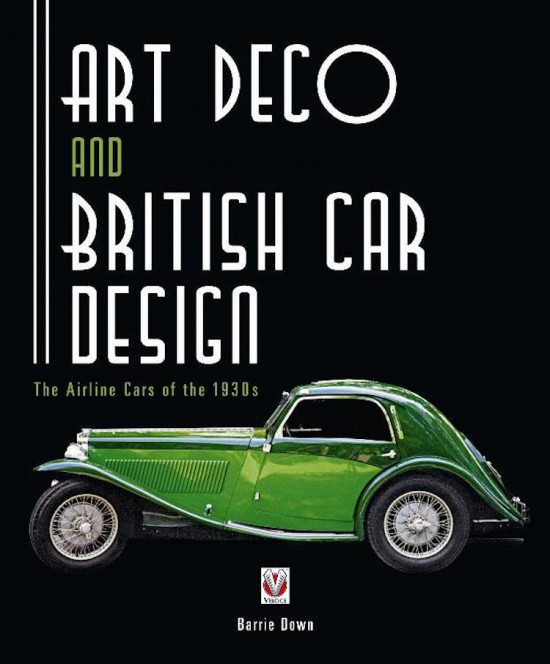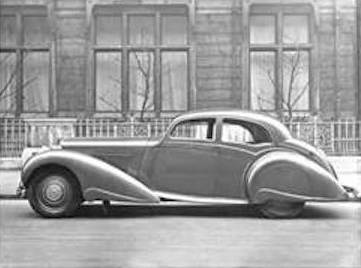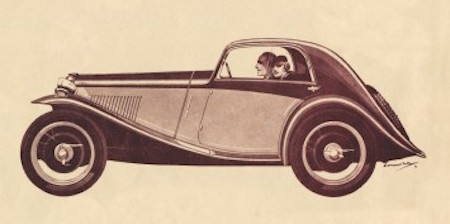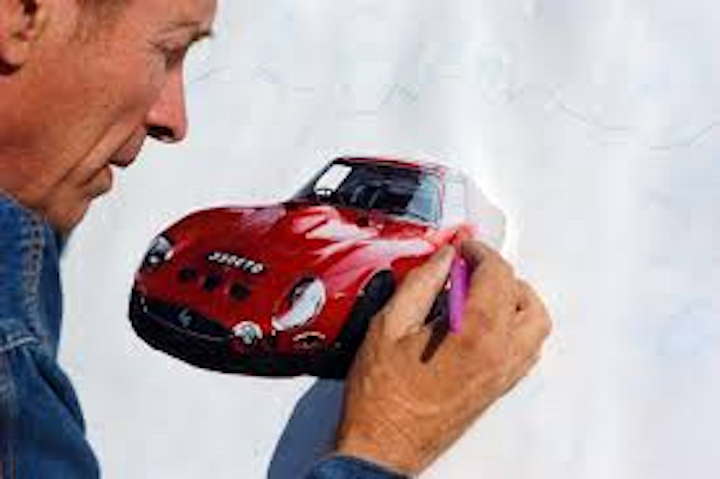by Wallace Wyss –
The first thing you have to do when approaching a book with such a title is to see if you agree with the author on what “art deco” is. I think Down has a pretty good handle on it, defining it as a “social movement” where a lot of things–architecture, furniture, train locomotives and cars were influenced by the aerodynamic development of airplanes during the Thirties, i.e “streamlined” but one area where he and I would clash is that I couldn’t find very many pictures of open cars, where I think one has to agree that there were many art deco cars (like the Delahaye 135 bodied by Figoni) that are extreme examples of art deco and yet they are also open cars (which reduces their aerodynamics by a bunch).
Also, though the Delahaye was not British, you get my point–that the influences of art deco are found in open cars as well as closed ones.
The book is roughly divided into two parts; the first explaining and illustrating the Art Deco styling elements that link streamlined car designs, the second part of the book going car brand by car brand in production cars made between 1933 and 1936 to show the art deco influence.
Since all of these cars in this book are British, it is very educational to see how “down market,” i.e. the opposite of luxury, the art deco influence went. In other words, even the MG TC had a “airline” or ”art deco” influenced model, and it is an extremely beautiful car regardless of what it sold for new (it was very low priced). That car alone shows how an inspired design, with a lofty goal as its objective, can be realized inexpensively as well as expensively.
A lot of the cars pictured here are foreign to me, like Siddenly, Hotchkiss, Standard, Salmson, Singer, Riley , Triumph and the like, brands of which only a few were imported to America, so it’s interesting to see how middle class cars got the benefits of which was tried first on the expensive cars like RR, Bentley, Lagonda, and Jaguar.
And when he does show expensive cars, he is showing some RR and Bentley models I haven’t seen pictured before, and it’s inexplicable to me why authors of histories of those expensive marques haven’t shown any art deco examples that occurred in “their” marques because, even though they might have been one-offs, they show the thinking of the auto company at the time. It’s sad to know that companies like Rolls, Bentley and Jaguar, with their more cosmopolitan customers who were always looking for something distinctive, didn’t offer more radical aero designs, except on occasion as a one-off. But it was not for naught. At least those one-off “specials” inspired makers of less expensive cars to embrace “aero.”
The book is high quality as far as printing, binding and reproduction. A little high-priced for a slim book but if you are like me, joyful at finding more elements of art deco design even in something like a clock or a radio, you’ll be happy to find a book that shows that art deco in cars wasn’t available only for the wealthy.
Because the influence of the art deco movement spread down to some of England’s lowest priced cars, if you’re contemplating buying a car solely for its style, there’s marques shown here that make great art deco design statements.
Title: Art Deco and British Car Design: The Airline Cars of the 1930s
Author: Barrie Down
Publisher Veloce Publishing
Length: 144 pages
Binding: Softbound (hardbound available)
Illustrations; 200, including color and b & w
Price: $44.95
THE REVIEWER: Wallace Wyss is the author of Incredible Barn Finds
series of books, available as a set of four or individually from Enthusiast Books, Hudson, WI.






I remember my headmaster taking me to Mt. Pleasant. There was an early MG-TC. British Racing Green, no less. He was buying the car and wanted me to drive it. 1955 was the year. The car had a balance to what it simply “was”. Rob Walker who wrote for Rod and Track would know the sensation. Art is sensation. The “boats” I was brought up in, going down narrow two lane highways with too much metal, this car looked “right”. “Art”, to me, has a direction and this little car was “right on the money”. Today, everything under the sun is “advertised” as a “Sports Car” but the British and “”Willy and Joe” coming home from World War Two bought us something that will always stick in my mind and not my craw. “Britian” does rule the waves!
Artfully said!
To my mind there were two primary interpretations of fluid forms in automobiles of this era:
Streamlining – the use of practical applied aerodynamic science as learned through the use of wind tunnels, mathematical calculations, and detailed analysis of fluids in direct reaction to surface geometry. This aspect was mostly developed by Germans leading up to the war. However Americans and British scientists used these theories as part of developing car bodies for racing use.
Art Deco Sculpting – Surface sculpture influenced by naturalistic forms, drapery, and fluid motion which may or may not encourage the efficiency of the form to move through air. Distinctly artful and visually pleasant with a greater sense of “intuitive” aerodynamics.
We see clear differences in interpretation from German to French cars, but US and British cars are harder to pin down specifically to each of these area. Interestingly, the use of aerodynamic science comes into play in the US with a significant focus in racing (Pete Brock and the Daytona Cobra) and salt flat racing (Chet Herbert and Beast III).
All this talk of streamlining, and no talk of the Chrysler Airflow lines of cars from the 1930’s. Although a complete flop due to their radical design, they were considered the epitome of streamlined automotive design at the time. Glenn in the Bronx, NY.